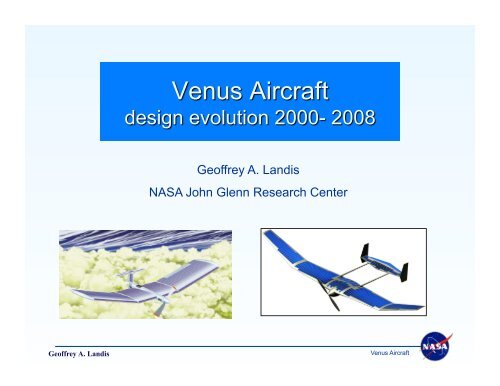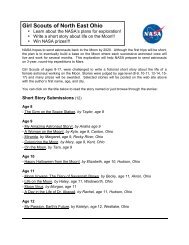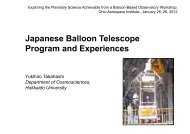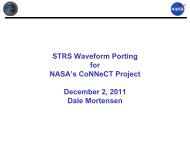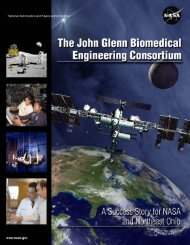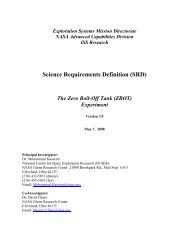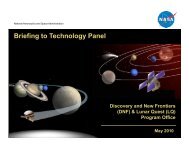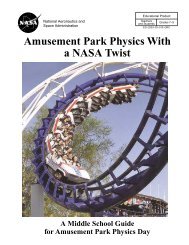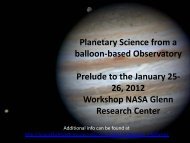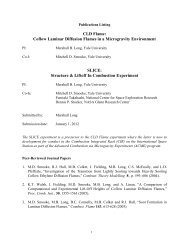Planes/UAV/Aircraft Design - Space Flight Systems - NASA
Planes/UAV/Aircraft Design - Space Flight Systems - NASA
Planes/UAV/Aircraft Design - Space Flight Systems - NASA
You also want an ePaper? Increase the reach of your titles
YUMPU automatically turns print PDFs into web optimized ePapers that Google loves.
Geoffrey A. Landis<br />
<strong>NASA</strong> John Glenn Research Center<br />
Geoffrey A. Landis<br />
Venus <strong>Aircraft</strong>
Atmospheric exploration trade-study<br />
• Balloon<br />
• Simple technology<br />
• Demonstrated on Venus<br />
• Altitude change possible,<br />
but difficult<br />
• Location change not<br />
possible<br />
• Airship<br />
• Difficult to stow and deploy<br />
• Altitude change possible,<br />
but difficult<br />
• Speed is slow:<br />
• cannot stationkeep<br />
• cannot stay in sun<br />
• Can keep latitude<br />
(depending on<br />
altitude)<br />
• Airplane<br />
• Airplane design uses<br />
terrestrial experience<br />
• Stow and deploy concepts<br />
demonstrated by ARES<br />
• Altitude change easy (within<br />
design limits)<br />
• Speed allows stationkeeping<br />
and continuous sun<br />
• Easy to keep latitude<br />
Geoffrey A. Landis<br />
Venus <strong>Aircraft</strong>
(simplified) Aerodynamics of flight on Venus<br />
• Horizontal flight requirement: lift on wing = gravity<br />
• F = ½ ρ C L A V 2 = mg<br />
Variables<br />
• ρ (atmospheric density): function of altitude<br />
• C L (lift coefficient): typically around 1 for optimum flight<br />
• A (wing area)<br />
• V (velocity)<br />
<strong>Flight</strong> velocity and power:<br />
• V = SQRT (mg/A)/(2ρC L )<br />
• Note that (m/A) = wing loading<br />
• Power = drag force times velocity<br />
• If we make the simplifying assumption that drag is proportional to lift<br />
via the L/D (lift to drag) ratio, and C L is approximately 1:<br />
• P = mg/(L/D)*V = (mg) 3/2 (L/D) (2ρA) -½<br />
Geoffrey A. Landis<br />
Venus <strong>Aircraft</strong>
Solar Airplane Figure of Merit<br />
• We can calculate a solar airplane figure of merit showing the ratio of<br />
sun intensity to the power required for level flight at a given wing area.<br />
The solar intensity is proportional to 1/d 2 , and power required to fly<br />
proportional to the square root of the atmospheric density. Thus: flying<br />
is easiest on a planet close to the sun with high atmospheric density:<br />
If we simplify by neglecting the parasitic drag (proportional to v 3 ) the figure of merit F is<br />
Planet d g (gravities) ! (bar) F<br />
(AU)<br />
Earth 1 1 1 1<br />
Venus 0.723 0.91 1 2.2<br />
Mars 1.524 0.38 0.0064 (average) 0.15<br />
Jupiter 5.203 2.36 (equat.) 1 0.01<br />
Saturn 9.572 0.92 (equat.) 1 0.01<br />
Titan 9.572 0.14 1.5 (at surface) 0.27<br />
For Venus, Jupiter, and Saturn, flight is assumed to be at the one bar level<br />
Does not include effect of atmospheric opacity<br />
Venus <strong>Aircraft</strong>
Solar energy vs <br />
altitude in the Venus <br />
atmosphere: <br />
data from Venus <br />
atmospheric probes <br />
• At surface, power<br />
available is 10% of<br />
exoatmospheric<br />
power at 1000 nm,<br />
Solar energy vs <br />
altitude in the Venus <br />
atmosphere: <br />
data from Venus <br />
atmospheric probes <br />
Above about 65 km,<br />
Venus atmosphere<br />
essentially clear<br />
Above about 50 km,<br />
Venus has more<br />
sunlight than Earth<br />
Geoffrey A. Landis<br />
Venus <strong>Aircraft</strong>
Solar Airplane Figure of Merit<br />
• 50-60 km above surface, Venus atmosphere density profile<br />
similar to Earth's<br />
• Airplane design can use Earth experience<br />
• Gravity 90% of Earth's<br />
• Powered flight easier<br />
• Above the clouds, Venus has more sunlight than Earth<br />
• Solar flight is easier on Venus than on Earth<br />
• Acid droplets in atmosphere require all exposed surfaces<br />
be corrosion resistant<br />
• Avoid exposed metal surfaces.<br />
• All metal surfaces need passivation coating<br />
• Acid-resistant materials are well developed technology<br />
Venus <strong>Aircraft</strong>
Solar airplanes on Earth<br />
Solar Impulse<br />
Aerovironment Pathfinder<br />
Sunseeker<br />
Geoffrey A. Landis<br />
<strong>NASA</strong> Glenn solar airplane team<br />
Venus <strong>Aircraft</strong><br />
Sky Sailor
Initial sketch of wing-folding<br />
for small aircraft for Venus<br />
2000 version<br />
fold line<br />
Aeroshell diameter<br />
1.2 meters<br />
<strong>Aircraft</strong> concept was essentially a flying-wing design. A small tail gives a small<br />
amount of additional control authority with no additional fold.
Early Venus aircraft design:<br />
3-D modelled
Venus airplane initial concept<br />
artist's conception by Les Bossinas
Variant 2000 small<br />
Venus aircraft<br />
Venus airplane<br />
3 folds<br />
Medium wing chord version
Small Venus aircraft:<br />
OAI 2001 proposal
Chris LaMarre's Venus<br />
Airplane configuration<br />
August 2001<br />
S = 1.6 m 2 <br />
b = 4.38 m <br />
AR = 12 <br />
Mass = 15 kg <br />
DF 101 and SG8000 airfoils<br />
investigated <br />
Geoffrey A. Landis<br />
Venus <strong>Aircraft</strong>
<strong>Design</strong><br />
concept<br />
2002
2002 folding concept<br />
Folded in aeroshell<br />
tail deployed
Venus<br />
airplane<br />
unfolding<br />
Geoffrey A. Landis<br />
Venus <strong>Aircraft</strong>
Superimposed on landscape
5.16 m<br />
Early in the RASC<br />
design process<br />
1.79 m<br />
0.6 m
Folding for initial<br />
RASC version<br />
Max Dia = 3.0m<br />
3.0m Aeroshell<br />
Height<br />
0.91m<br />
70 Deg Cone Angle
RASC- August 2003<br />
(closer to final)
RASC- August 2003<br />
(rendered)
RASC- August 2003<br />
(folding scheme still needs work!)
RASC Venus airplane: final design<br />
See animation at<br />
• http://www.lpi.usra.edu/vexag/may2008/presentations/19Landis.mov<br />
Geoffrey A. Landis<br />
Venus <strong>Aircraft</strong>
Venus<br />
airplane:<br />
plan view
3.7 meter diameter aeroshell<br />
-the size of the Viking lander entry system<br />
-Aeroshell shape based on Mars Pathfinder<br />
<strong>Aircraft</strong> folded into aeroshell<br />
Side view<br />
Top view
RASC Venus<br />
airplane<br />
Visualization
Venus Airplane entry mass<br />
VENUS AIRPLANE MASS SUMMARY<br />
NOTE: Only chage numbers in Blue<br />
System Description Mass Fraction Mass (kg) Source<br />
Airplane 20% 103 NA<br />
Heatsheild Structure 7% 36.05 Pioneer<br />
Heatsheild TPS 13% 66.95 Pioneer<br />
Backshell Structure<br />
(Gussets, Separation ftgs,<br />
Paint, Vent, etc) 12% 61.80 Pioneer<br />
Backshell TPS 8% 41.20 Pioneer<br />
Parachute System 10% 51.50 Pioneer<br />
Airplane Deployment<br />
Mechanism (Separation from<br />
Backshell) 15% 77.25 Mars Airplane<br />
Misc (COMM, Power, Ballast,<br />
etc) 15% 77.25 Mars Airplane<br />
Total Entry Mass 100% 515<br />
Contingency Mass 30% 155<br />
Total With<br />
Contingency 670<br />
NOTE: Mass Fractions Based off Mars Airplane Data Venus Pioneer<br />
RCS System Description Quanty Mass (kg) Source<br />
Hardware NA 51.9 NA<br />
* Marquardt 100lbf
Boston University Venus airplane student design,<br />
XQ-V1<br />
• 2008. Image courtesy of Greg Thanavaro, Boston University<br />
Dept. of Aerospace Engineering<br />
Geoffrey A. Landis.<br />
Venus <strong>Aircraft</strong>
Mars airplane<br />
• 6.25 m span<br />
• Aspect ratio 5.6<br />
• 101 kg including margin<br />
ARES Mars airplane demonstration models<br />
Geoffrey A. Landis<br />
Venus <strong>Aircraft</strong>
Power Required to fly at wind speed versus solar availability<br />
1000000<br />
• Calculation for 18% solar cell efficiency with 80% packing<br />
Power (W)<br />
100000<br />
10000<br />
Power Required<br />
12 m<br />
9 m<br />
6 m<br />
12 m<br />
Point design<br />
for RASC<br />
High airplane altitudes: low density:<br />
too much power needed<br />
to reach airspeed high<br />
enough for level flight<br />
1000<br />
6 m<br />
9 m<br />
Lower altitudes: easy to<br />
fly, but takes too much<br />
power to fly at wind speed<br />
Power Available<br />
100<br />
0 10 20 30 40 50 60 70 80<br />
Altitude (km)<br />
Geoffrey A. Landis
Power Required to fly at wind speed versus solar availability<br />
• Effect of higher solar cell efficiency (with 80% packing)<br />
• Calculation for 18% solar cell efficiency with 80% packing<br />
9m (32% eff, double sided)<br />
9m (32% eff)<br />
9m (18% eff)<br />
12 m wing (18% cells) =<br />
9 m wing (32% cells) =<br />
• Double sided array<br />
calculation assumes 77%<br />
albedo<br />
6 m wing (32% + double sided)<br />
Geoffrey A. Landis
Wind model used
Publications<br />
• G. Landis, “Exploring Venus by Solar Airplane,” STAIF Conference on <strong>Space</strong> Exploration Technology, Albuquerque NM,<br />
Feb. 11-15, 2001. AIP Conference Proceedings Volume 552, 16-18.<br />
• G. Landis, C. LaMarre and A. Colozza, “Solar <strong>Flight</strong> on Mars and Venus,” 17th <strong>Space</strong> Photovoltaic Research and<br />
Technology Conf., <strong>NASA</strong> John Glenn Research Center, Cleveland OH, November 10-13, 2001; <strong>NASA</strong> CP-2002-211831,<br />
126-127.<br />
• G. Landis, C. LaMarre and A. Colozza, “Atmospheric <strong>Flight</strong> on Venus,” paper AIAA-2002-0819, AIAA 40 th Aerospace<br />
Sciences Meeting, Reno NV, January 14-17, 2002. <strong>NASA</strong> Technical Memorandum 2002-211467 (2002).<br />
• G. Landis, C. Lamarre, and A. Colozza, “Venus Atmospheric Exploration by Solar <strong>Aircraft</strong>,” Acta Astronautica, Vol. 56,<br />
No. 8, April 2005, 750-755. Paper IAC-02-Q.4.2.03, 53 rd International Astronautical Congress, Houston TX, Oct. 2002.<br />
• G. Landis, C. LaMarre and A. Colozza, “Atmospheric <strong>Flight</strong> on Venus: A Conceptual <strong>Design</strong>,” Journal of <strong>Space</strong>craft and<br />
Rockets, Vol 40, No. 5, 672-677 (Sept-Oct. 2003).<br />
• A. Colozza, G. Landis, and V. Lyons, “Overview of Innovative <strong>Aircraft</strong> Power and Propulsion <strong>Systems</strong> and Their<br />
Applications for Planetary Propulsion,” <strong>NASA</strong> Technical Memorandum TM 2003-212459 (2003).<br />
• G. Landis and A. Colozza, “Solar Airplane for Venus, “ Research and Technology 2003, <strong>NASA</strong> TM 2004-212729, 47-48<br />
(2004).<br />
• G. Landis, “Robotic Exploration of the Surface and Atmosphere of Venus,” Acta Astronautica, Vol. 59, 7, 517-580<br />
(October 2006). Presented as paper IAC-04-Q.2.A.08, 55th International Astronautical Federation Congress, Vancouver<br />
BC, Oct. 4-8 2004.<br />
• A. Colozza and G. Landis, “Evaluation of Long-Duration <strong>Flight</strong> on Venus,” paper AIAA 2005-7156, AIAA Infotech<br />
Aerospace Conference 2005, Arlington VA, September 26-29, 2005. <strong>NASA</strong> Technical Memorandum TM-2006-214452<br />
(2006).
(simplified) Aerodynamics of flight on Venus<br />
For flying at a given velocity:<br />
• C L A = 2mg/ρV 2<br />
• To fly faster, we can either decrease the wing area at constant C L , or else decrease C L ,<br />
and hence fly at a less-optimum lift conditions<br />
• Power = drag force times velocity<br />
• the simplifying assumption that drag is proportional to lift via L/D (lift to drag) ratio<br />
becomes poor for flight far from optimum C L<br />
• Optimally, you would want to stay at optimum C L and vary wing area<br />
• But the constant L/D approximation ignores parasitic drag, which becomes more<br />
important as wing area decreases<br />
• P = mgV/(L/D)<br />
• If you could optimize everything and ignore parasitic drag, the power required to<br />
fly is independent of density and proportional only to velocity<br />
• But, for a solar aircraft, P is proportional to intensity time wing area A<br />
• Iterative design process needed<br />
• Too simplified: Parasitic drag can’t be ignored!<br />
Geoffrey A. Landis<br />
Venus <strong>Aircraft</strong>


